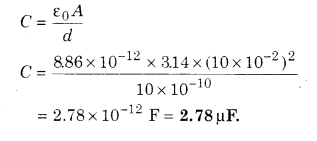Rajasthan Board RBSE Class 12 Physics Chapter 4 Electrical Capacitance
RBSE Class 12 Physics Chapter 4 Text Book Exercise with Answers
RBSE Class 12 Physics Chapter 4 Multiple Choice Type Questions
RBSE Solutions For Class 12 Physics Chapter 4 Question 1.
The capacitance of an isolated spherical conductor is proportional to :
(a) C ∝ R
(b) C ∝ R2
(c) C ∝ R-2
(d) C ∝ R-1
Answer:
(a) C ∝ R
Capacitance of spherical conductor
C = 4πε0R
⇒ C ∝ R
RBSE Solutions For Class 12 Physics Question 2.
The equivalent capacitance between points A and B in the given figure :
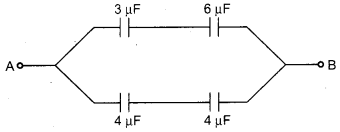
(a) 2 µF
(b) 4 µF
(c) 25 µF
(d) 3 µF
Answer:
(b) 4 µF
Adding capacitors 3 µF and 6 µF in series
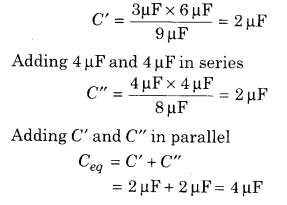
RBSE Class 12 Physics Chapter 4 Question 3.
If the plates of a charged capacitor are connected with a conducting wire, then :
(a) The potential will be infinite
(b) Charge will be infinite
(c) Charge will become double the initial value
(d) Capacitor will be discharged
Answer:
(d) Capacitor will be discharged
On connecting both plates of capacitor, then due to conduction, capacitor discharges.
RBSE Solutions For Class 12th Physics Question 4.
The equivalent capacitance between the points A and B in the given figure :
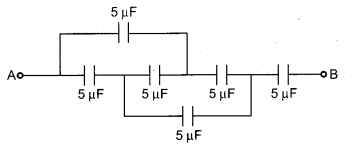
(a) 5 µF
(b) 2.5 µF
(c) 10 µF
(d) 20 µF
Answer:
(b) 2.5 µF
Arranging the figure
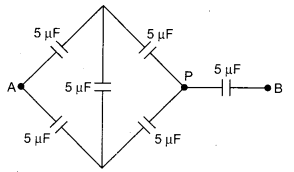
The equivalent capacitance between the point A and P is C’
C’ = 5 µF
Adding C’ and 5 µF in series
\(C^{\prime \prime}=\frac{5 \mu \mathrm{F} \times 5 \mu \mathrm{F}}{10 \mu \mathrm{F}}=2.5 \mu \mathrm{F}\)
RBSE Solution Class 12 Physics Question 5.
The ratio of the radius of two spherical conductors is 1 : 2, then the ratio of their capacitances will be :
(a) 4 : 1
(b) 1 : 4
(c) 1 : 2
(d) 2 : 1
Answer:
(c) 1 : 2
For spherical conductor C ∝ R

RBSE Solutions Physics Class 12 Question 6.
In a figure, the dielectric substance present in the half part of the plates of a parallel plate capacitor, whose dielectric constant is er, is displaced. If the initial capacitance of the capacitor is C, then the now capacitance will be :
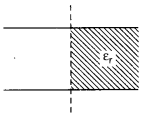

Answer:
(a)
The arrangement shown in the figure is equivalent to the two capacitor joined in parallel. The area of plate in each capacitor is A/2
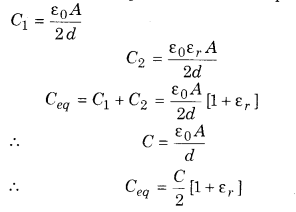
Class 12 Physics RBSE Solutions Question 7.
Eight Mercury drops of equal radius and equal charge combine to form a big drop. The capacitance of big drop in comparison the each small drop will be :
(a) 2 times
(b) 8 times
(c) 4 times
(d) 16 times
Answer:
(a) 2 times
Volume of big drop = 8 × Volume of small drop
\(\frac{4}{3}\)πR3 = 8 × \(\frac{4}{3}\)πr3
R = 2r
Capacitance of small drop C1 = 4πε0r
Capacitance of bigger drop C2 = 4πε0R
\(\frac{C_{1}}{C_{2}}=\frac{r}{R}=\frac{r}{2 r}\)
C2 = 2C2
RBSE Solutions 12 Physics Question 8.
The capacitance of a capacitor is C. It is charged till the potential difference of V. Now, if it is related to the resistance, then the amount of loss of energy is :

Answer:
(b)
Energy decay = Stored energy in capacitor
= \(\frac{1}{2}\)CV2
RBSE Solution Physics Class 12 Question 9.
If the stored energy is Q on charging a capacitor by charge Q. The stored energy on doubling the charge will be :
(a) 2 W
(b) 4 W
(c) 8 W
(d) \(\frac{1}{2}\) W
Answer:
(b) 4 W
Energy stored in capacitor (U) = \(\frac{q^{2}}{2 C}\)
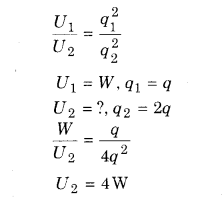
RBSE Solution Class 12th Physics Question 10.
Two spheres of 3 μF and 5 μF are charged by potential of 300 V and 500 V respectively. The common potential will be :
(a) 400 V
(b) 375 V
(c) 425 V
(d) 350 V
Answer:
(c) 425 V
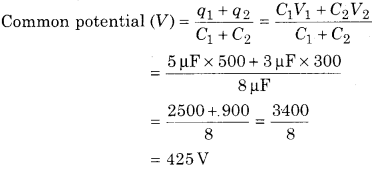
Physics Class 12 RBSE Solutions Question 11.
The potential energy between plates of a charged parallel plate capacitor is UQ. If a dielectric plate of dielectric constant er is placed between The gap of plates, then the new potential energy will be :
(a) \(\frac{U_{0}}{\varepsilon_{r}}\)
(b) U0εr2
(c) \(\frac{U_{0}}{\varepsilon_{r}^{2}}\)
(d) U0
Answer:
(a) \(\frac{U_{0}}{\varepsilon_{r}}\)
Energy decreases to εr times
U = \(\frac{U_{0}}{\varepsilon_{r}}\)
12th Physics RBSE Solutions Question 12.
In a given figure, the potential difference across 4.5 μF capacitor in the circuit is :
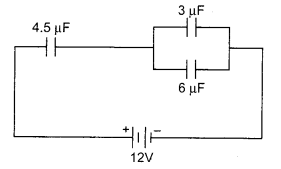
(a) \(\frac{8}{3} \mathrm{V}\)
(b) 4 V
(c) 6 V
(d) 8 V
Answer:
(d) 8 V
Adding 6 μF and 3 μF in parallel
C1 = 6 μF + 3 μF = 9μF
Adding C1 and 4.5 μF in series
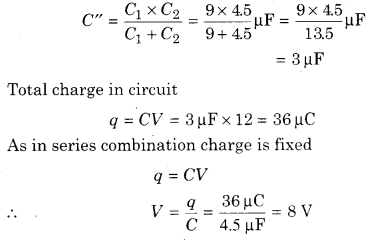
12 Physics RBSE Solutions Question 13.
The equivalent capacitance between the points A and B in the circuit shown in figure :
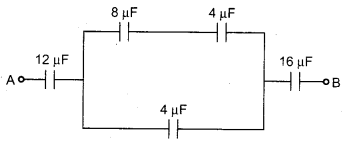
(a) 1 F
(b) 9 F
(c) 1.5 F
(d) 3.38 μF
Answer:
(d) 3.38 μF
Adding 8 μF and 4 μF in series
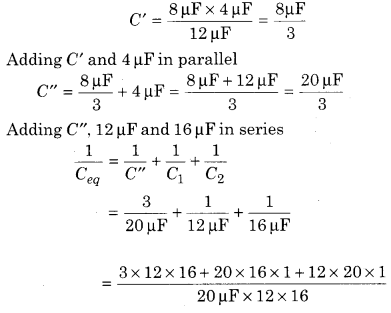

RBSE Class 12 Physics Chapter 4 Very Short Answer Type Questions
RBSE Solutions 12th Physics Question 1.
If the area of a parallel plate capacitor is halved. Then would this device will work as capacitor.
Answer:
No, because charge on both plates become unequal.
RBSE Solutions Class 12th Physics Question 2.
Three capacitors each of capacitance 6 μF are arranged. What would be the value of maximum and minimum capacitances?
Answer:
(i) For maximum capacitance, they are connected in parallel
∴ Cmax = C1 + C2 + C3 = 6 μF + 6 μF + 6 μF = 18 μF
(ii) For minimum capacitance, they should be connected in series

RBSE Solution Of Class 12th Physics Question 3.
On what factors does the capacitance of a conductor depend?
Answer:
The capacitance of a conductor depend on area of cross-section and medium surrounding the conductor.
RBSE Solutions Of Class 12 Physics Question 4.
What is value of capacitance of earth when it is consider to be a spherical conductor?
Answer:
Capacitance of spherical conductor
= 4πε0R = \(\frac{6.4 \times 10^{6}}{9 \times 10^{9}}\) = 711 μF
Capacitance Class 12 Question 5.
What is the resultant electric field between the plates of a charged parallel plate capacitor when the surface charge density of plates is σ?
Answer:
Resultant electric field E = \(\frac{\sigma}{\varepsilon_{0}}\)
Question 6.
What is the equivalent capacitance in series combination when n capacitors of equal capacitances C ?
Answer:
Cresultant = \(\frac{C}{n}\)
Question 7.
Write the formula for energy density between the plates of a parallel plate capacitor.
Answer:
U = \(\frac{U}{V}=\frac{1}{2}\) ε0E2
Question 8.
Write the unit of energy density.
Answer:
Joule/m3
Question 9.
The capacitances of two capacitors are C1 and C2. If they are given equal charges, then, what is the ratio of the electric potential energies?
Answer:

Question 10.
Which conductor can be given almost infinite charge?
Answer:
Earth. It has very large capacitance.
Question 11.
In which form the energy of charged capacitor is stored?
Answer:
Energy of the capacitor is stored as electric energy between the plates of capacitor.
Question 12.
What is the net electric charge on the charged capacitor?
Answer:
Zero
Question 13.
On filling the plates of a parallel plate capacitor completely with a dielectric, the capacitance becomes 5 times. What is the dielectric constant of the dielectric?
Answer:
On introducing medium
![]()
Question 14.
What is the basic use of capacitor?
Answer:
The main use of capacitor is to store electric charge and electric energy.
Question 15.
The distance between the plates of a parallel plate capacitor is d. If a metallic plate of thickness \(\frac{d}{2}\) is placed between the plates, what will be the effect on the capacitance.
Answer:
For metallic plate,

Hence capacitance becomes double.
Question 16.
How much work is done to charge a capacitor of capacitance 24 μF when the potential difference between the plates is 500 V?
Answer:
Work (VF) = qV
W = 24 × 10-6 × 500 × 500
= 6 J
Question 17.
If you have given capacitors of low capacitance. How will you get more capacitance from these capacitors?
Answer:
By connecting these capacitors in the parallel combination.
Question 18.
What is the equivalent capacitance when the capacitors of capacitance of 2μF are connected in series combination?
Answer:

Question 19.
What is the effect on capacitance on a parallel plate capacitor when the capacitor is immersed in oil? The dielectric constant of oil is 2.
Answer:
Capacitance Cm in any medium
Cm = KC0, K = 2
∴ Capacitance will be doubled.
Question 20.
A circular parallel plate capacitor has radius r. Air is filled between the plates. If the capacitance of capacitor is equal to that of the sphere of radius R, then what is the distance between the plates.
Answer:
Capacitance of parallel plate capacitor
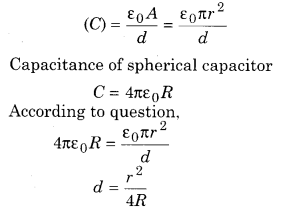
RBSE Class 12 Physics Chapter 4 Short Answer Type Questions
Question 1.
Explain conductors and insulators with examples.
Answer:
(a) Conductors : The substance in which the electric current flows from one place to another place easily are called conducting materials. For example, Silver, Copper, Aluminium, Iron, Mercury, Salt solution, Acid, Base, Human body and Earth, etc. are good conductors of electricity. Silver is the best conductor. When the charge is given to the conductor, it gets distributed readily over the entire surface of the conductor and no charge is found inside the conductor.
(b) Insulators : The substances in which the electric current cannot flow easily are called insulating
substances or insulator. For example, Glass, Plastic, Rubber, Ebonite rod, Dry wood, etc. are insulating substances. They are also called dielectric substances. Some of the solids may be semiconductors. We will study about the semiconductors in chapter 16. In this chapter, we will see why is there any difference in the behaviour of electrical conduction in various types of solid substances.
Question 2.
Differentiate polar and non-polar dielectrics.
Answer:
(a) Polar Dielectrics : Those substances in which the centre of positive and negative ions of molecules are not concentrated but are separated, are called polar dielectric substances. Each molecule of these substances have net permanent electric dipole moment and each molecule behaves like an electric dipole. For example, HCl molecule [figure 4.1 (a)(i)], H2O [figure 4.1 (a) (ii)] etc.
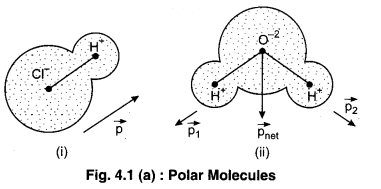
In absence of an external electric field, the molecules of a polar dielectric substance are arranged in irregular manner due to thermal energy. Due to this, any volume of a substance which has molecules in large amount has zero resultant dipole moment and thus, the resultant dipole moment of the substance is zero [figure 4.1 (b) (i)]. On placing the substance in external electric field, each molecule applies torque on the dipole that tries to align the molecule along the direction of external electric field. On increasing the electric field intensity of the external electric field, more of the molecule get align themselves in the direction of the external electric field. Thus, there is net dipole moment in the substance.
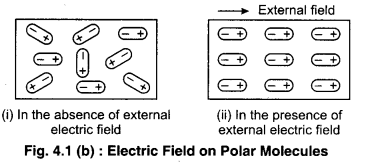
(b) Non-polar Dielectrics : Those substances in which the centre of both positive and negative charges of the molecules are coincide, are called non-polar dielectric substances. For example, H2, C02, N2 and 02 etc. Figure 4.1 (c)(i) shows H2 molecule and 4.1 (c)(ii) shows C02 molecule. Each molecule of these substances has zero dipole moment. Thus, the net dipole moment of the whole substance is zero.
If a non-polar dielectric substance is kept in an external electric field, then the centre of the positive charge is along the electric field and the centre of the negative charge is displaced opposite to the direction of the electric field. This induces some dipole moment in each molecule.
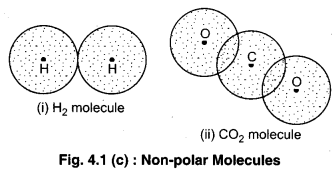
“The induction of electric dipole moment in a dielectric substance in the presence of external electric field is called the polarization of dielectric substance.”
Question 3.
Obtain the formula for capacitance of a spherical conductor.
Answer:
Capacitance of a Spherical Capacitor
Construction of spherical capacitor is shown in following figure 4.11. It consists of two concentric spherical plates A and B. Outer plate B is connected with Earth and inner plate A is given charge +q. Positive charge induced on B goes to Earth and negative charge remains on this plate. Therefore, potential produced on inner plate.
V = V1 + V2
Where, V1 = potential due to its own charge
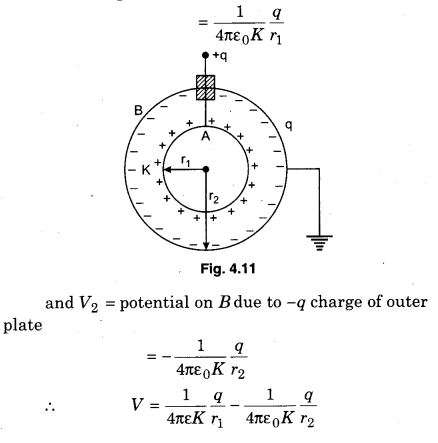
Here K is the dielectric constant of medium present between the two plates.
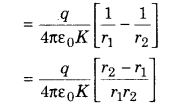
Since outer plate B is connected with Earth, therefore its potential will be zero.
∴ Potential difference between two plates,
= V – o = V
Therefore, the capacitance of the spherical capacitor,
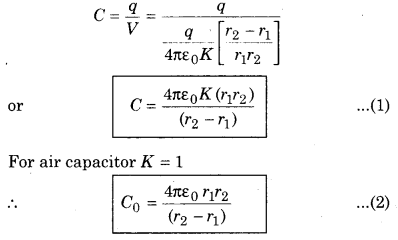
From equation (1), it is clear that the capacitance of spherical capacitor can be increased as below :
(i) Capacitance can be increased by increasing r1 and r2 but this method is not adopted because it is against the principle of capacitor.
(ii) C ∝ K, therefore placing the dielectric slab of high value of dielectric constant, between the plates of the capacitor.
(iii) C ∝ \(\frac{1}{\left(r_{2}-r_{1}\right)}\) i. e., by decreasing the distance between the plates, capacitance can be increased.
Question 4.
What will be the effect on the potential between the plates of a charged parallel plate capacitor when both plates are carry nearest to each other. While the charge is constant. Explain?
Answer:
q = CV
⇒ V = \(\frac{q}{C}\)
or, V ∝ \(\frac{1}{C}\) (when charge is constant)
On bringing them near d decreases but according to C = \(\frac{\varepsilon_{0} A}{d}\), C increases. Due to which potential d
difference between plates decreases.
Question 5.
A parallel plate capacitor is charged by a battery to V potential difference, when air is between the plates. Without removing the capacitor from battery, air is removed by a dielectric medium of dielectric constant eεr. What is the effect on following explain with reasons:
(i) Potential difference?
(ii) Electric field between plates?
(iii) Capacitance?
(iv) Charge?
(v) Energy?
Answer:
When battery remains connected :
(i) When the battery remains connected then the potential between the plates is equal to the potential of battery. This, the potential remains constant.
(ii) Capacitance becomes K times by the relation (Cm) = KC0
(iii) Charge will increase (according to q = CV) or it means it become K times.
(iv) Electric field

Thus no effect on the electric field.
(v) The energy of capacitor
U = \(\frac{1}{2}\)CVm
put V = const
∴ U ∝ C
Hence the energy stored by the capacitor is also increased K times.
Question 6.
A parallel plate capacitor is charged by a source to V0 potential difference. It is removed from supply and its plates are filled by a dielectric material. What would happen to the following explain with reasons :
(i) Charge
(ii) Potential difference
(iii) Capacitance
(iv) Electric field
(v) Energy
Answer:
After removing the battery :
(i) Capacitance become K times.
(ii) Charge remains unchanged due to the conservation of charge.
(iii) Potential difference V = \(\frac{q}{C}\) [decreases because C increases].
(iv) Due to decrease in V, E will decrease by the relation E = \(\frac{V}{d}\)
(v) On the basis of U = \(\frac{1}{2} \frac{q^{2}}{C}\) energy will decrease by the factor of K.
Question 7.
Obtain the formula for stored energy in a charged capacitor.
Answer:
Energy Stored in a Capacitor
As described earlier, the important application of capacitors is to store energy. In this section, we will get a detailed explanation about storing energy in capacitors.
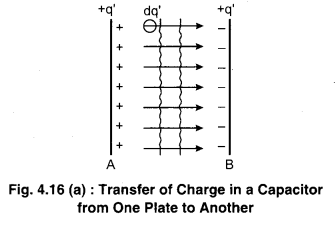
In the previous chapter, we have seen that some electric potential energy U is related to the structure of charge is equal to the work done by an external agent. Electric energy is stored in a capacitor and during charging, it is equal to the work done by the external agent. To understand this process of charging, we can imagine that an external agent removes electrons from the positive plate of the capacitor and pushes them to the negative plate and hence, charge is separated. Generally, this charging is done by the stored chemical energy of a battery.
Let at any instant t, the charge q’ be already transferred from one plate to another. In this instant, the potential difference V’ between the plates of a capacitor,
V’ = \(\frac{q^{\prime}}{C}\)
Now, the work done in transfering the charge dq,
dW = V’dq ………… (1)
This work is stored in the form of potential energy in the capacitor. Total work done in charging the capacitor from zero to charge Q
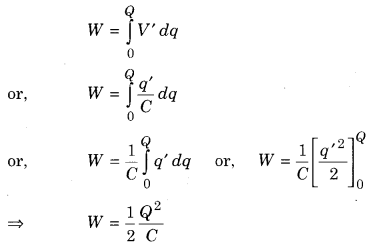
Thus, the energy stored in charged capacitor,
U = W
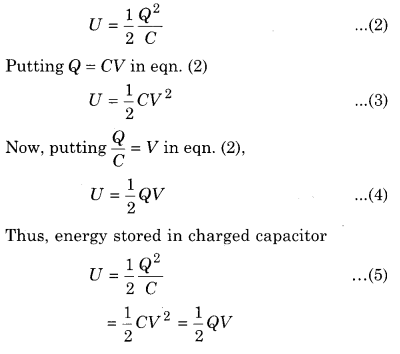
This formula is electric potential energy of a charged conductor. Consider two capacitors 1 and 2 whose area A is same. The capacitance of capacitor 1 is half of that of capacitor 2. Let the charges on both the capacitors be q, then the electric field between the two plates, E = \(\frac{q}{\varepsilon_{0} A}\) will be same. Now, due to difference in capacitance, it is clear from equation (2), that the potential energy of capacitor 1 is double the capacitor.
Question 8.
Three capacitors of capacitances C are first arranged in series and then in parallel combination. What would be the ratio of equivalent capacitances in both the cases?
Answer:
(i) In parallel
Cp = C1 + C2 + C3 = 3C ……………. (i)
(ii) In series
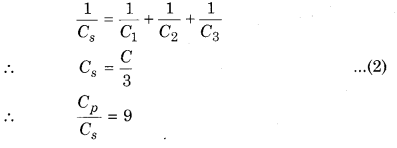
Question 9.
n capacitors of equal capacitances are arranged in series and its equivalent capacitance is CS and when arranged in parallel, its equivalent capacitances is Cp. Determine \(\frac{C_{p}}{C_{s}}\)
Answer:
In the same way as in question number 8.
\(\frac{C_{p}}{C_{s}}\) = n2
Question 10.
Define electrical capacitance and write its S.I. unit.
Answer:
Thus the electric capacitance of a conductor is a constant. Its value depends upon the nature and area of the conductor and on the environment around the conductor and also on the other conductors placed near the conductor.
∴ From equation
C = \(\frac{q}{V}\)
i. e., ‘the ratio of charge given to a conductor and potential raised due to this charge is called the electric capacitance of the conductor.’
Again from C = \(\frac{q}{V}\)
if V = 1 volt, then C = q
i. e., the electrical capacitance of a conductor is equal to charge of conductor when the applied potential on a conductor take as unity.’
Unit and Dimensions :
∵ C = \(\frac{q}{V}\)
∴ Unit of capacitance = \(\frac{\text { coulomb }}{\text { volt }}\) = CV-1 = Farad (F)
∴ 1CV-1 = 1F
If q = 1C, V = 1 volt, then C = 1F
i. e., ‘If on giving a charge of 1C to a conductor its potential is increased by 1 volt, then the capacitance of the conductor will be 1F.’
Farad is a big unit of capacitance. In practice other small units e.g, μF and μμF or pF are used.
1 μF = 10-6F
and 1 μμF = 1 pF = 10-12 F
Dimensional formula:
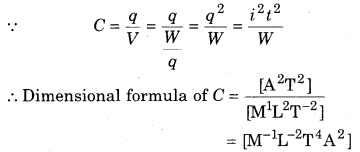
Graph : If a graph is plotted between q and V, then the straight line is obtained.
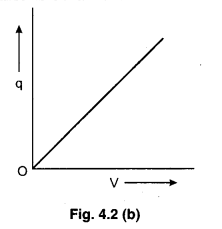
The gradient of the graphical line = tanθ = \(\frac{q}{V}\) = C
i.e., the gradient of the graph provides the capacitance of the conductor.
Question 11.
On increasing the charge on a spherical conductor by three times, what is the effect on its capacitance? Give reason.
Answer:
Capacitance of spherical conductor
C = 4πε0R
∴ There will be no effect of charge.
Question 12.
On keeping a dielectric plate in between an air capacitor of 2 μF capacitance, its capacitance becomes 5 μF. Determine the dielectric constant of the material.
Answer:
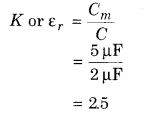
Question 13.
Two charged conductors have radii R1 and R2 respectively, their capacitances are C1 and C2 respectively and charges and potentials are Q1, Q2 and V1, V2 respectively, (V1 > V2). If the conductors are joined together by a conducting wire of negligible capacitance. Then, prove that the ratio of change in potentials is \(\frac{\Delta V_{1}}{\Delta V_{2}}=\frac{C_{2}}{C_{1}}\)
Answer:
Redistribution of Charges
From figure 4.17, two isolated conductors A and B are of radii R1and R2 respectively and the capacitances are C1 and C2 respectively. On charging A by Q1 and B by Q2 , their potentials become V1 and V2 respectively.
Before joining the conducting wire,
Q1 = C1V1 ………….. (1)
and Q2 = C2V2 ………… (2)
Thus, total amount of charge on both the conductors,
Q = Q1 + Q2
or, Q = C1V1 + C2V2 ………… (3)
Now, if both the conductors are attached by a conducting wire of negligible resistance or capacitance. Then charge always flow the conductor of high potential to low potential and flows till the potential on both the conductors is same. In electrical equilibrium, let the potential be V and charges on the conductors be Q’1 and Q’2 respectively. Then, total capacitance on arrangement of the two conductors as a system, C = C1 + C2 because the potential on both the conductors is same and hence the conductors are in parallel combination.
After redistribution of charges,
Q’1 = C1V ………………. (4)
Then, total charge after redistribution,
Q = Q’1 + Q’2 = (C1 + C2) V
From law of conservation of charge,
C1V1 + C2V2 =(C1 + C2)V …………. (5)
Thus, common potential,
V = \(\frac{C_{1} V_{1}+C_{2} V_{2}}{C_{1}+C_{2}}\) …………. (6)
Thus, after redistribution of charges, the ratio of charges of conductors,
\(\frac{Q_{1}^{\prime}}{Q_{2}^{\prime}}=\frac{C_{1} V}{C_{2} V}=\frac{C_{1}}{C_{2}}\) …………….. (7)
After redistribution of charges, the ratio of charges of conductors is in the ratio of their capacitances.
If V1 > V2
Then, V1 > V > V2
Change in potential of first conductor,
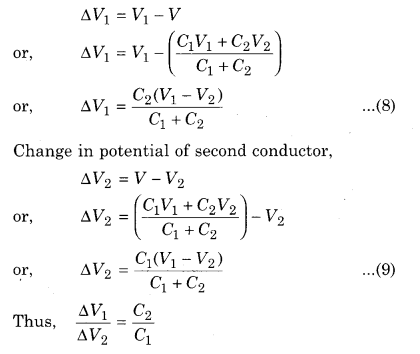
Hence, after the redistribution of charges, the ratio of change in potential of conductors is equal to the reciprocal of the ratio of their capacitances.
Question 14.
What is a capacitor? Explain.
Answer:
Capacitor
The capacitance of a conductor can be increased by increasing its size but the increase in the size of conductor is not practical solution.
A capacitor is a device in which the capacitance of a conductor is increased by keeping the change constant and reducing the potential, without changing the size of the conductor. There are two conducting plates placed close to each other. One of them is positively charged and the another one has equal amount of negative charge. For this, both the plates are connected to positive and negative terminals of the battery (figure 4.4 (a)). Now, if the battery is removed, still there is charge stored on the conductors. Thus, we can say that a capacitor is a charge storing device.
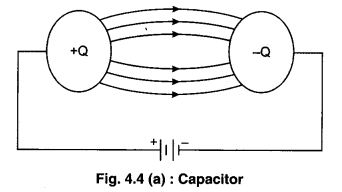
The total charge on a capacitor is Q + (-Q) = 0. Generally, by the charge on capacitor, we mean that charge on any of its plates has magnitude (Q). The potential difference V between the plates of the capacitor is called potential of the capacitor.
For a capacitor,
Q ∝ V
or, Q = CV
The shape of the plates of the capacitor can be rectangular, cylindrical or spherical. The capacitance of a capacitor C, depends upon the size, shape, distance between the plates and the medium present between the plates. A capacitor is a device to store electrical energy.
Figure 4.4 (b) shows the symbol of capacitor used in circuit diagrams
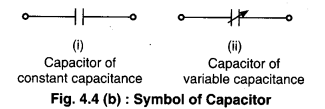
Question 15.
Three capacitors C1, C2 and C3 are connected in series. Obtain the relation for equivalent capacitance.
Answer.
Series Combination of Capacitors
To obtain small capacity from capacitors of large capacity, series combination of capacitors is adopted. In following diagram three capacitors of capacitances C1, C2 and C3 are joined in series. In this combination the charge stored on each capacitor will be the same as that given to combination. Since q is same for all capacitor, then their individual potential differences will be different say V1, V2, V3 respectively. If V be the total potential difference of the combination then
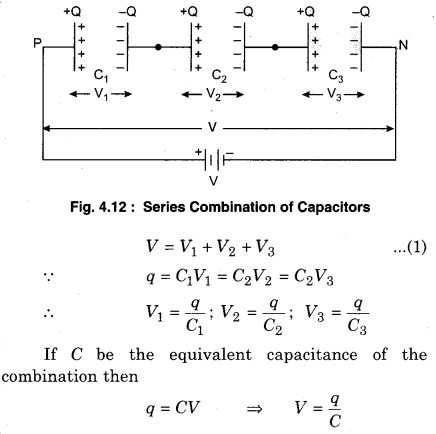
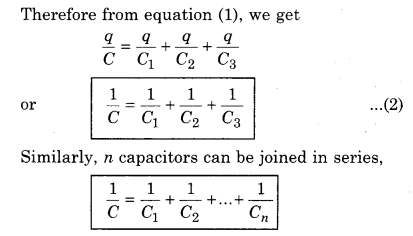
Question 16.
Three capacitors C1, C2 and C3 are connected in parallel combination. Obtain the relation for equivalent capacitance.
Answer:
Parallel Combination of Capacitors
This combination is adopted when greater capacity is required from smaller capacities. In this combination one plate of each capacitor is connected at one junction and other plates on other junction as shown in following diagram. The junctions are A and B. Suppose +q charge is given to this combination. This charge is distributed on capacitors according to their capacities.
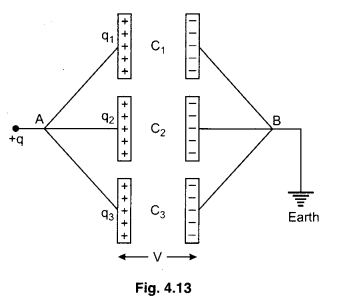
∴ q1 + q2 + q3 …………….. (1)
Since all the capacitors are joined between Aand.EI therefore the potential difference of all the capacitor will be same.
∴ V = \(\frac{q_{1}}{C_{1}}=\frac{q_{1}}{C_{2}}=\frac{q_{3}}{C_{3}}\)
∴ q1 = C1V, q2 = C2V, q3 = C3V
If C be the equivalent capacity combination,
then q = CV
Therefore from equation (1),
CV = C1V + C2V + C3V
Similarly n capacitors can be joining in parallel
C = C1 + C2 + C4 +… + Cn
RBSE Class 12 Physics Chapter 4 Long Answer Type Questions
Question 1.
Obtain the relation for capacitance of a parallel plate capacitor and explain its principle.
Answer:
Principle of Capacitor
The principle of capacitor can be understood in following three stages :
(i) Suppose the potential of a conductor A is increased by V on giving a charge q, then its capacity,
C = \(\frac{q}{V}\) ……………. (1)
(ii) Now if another similar uncharged conductor B is brought near this conductor, then it is charged by induction as shown in figure 4.5 (b).
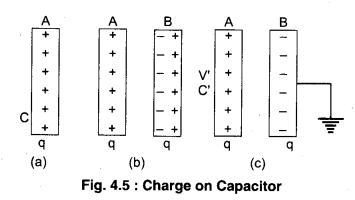
(iii) Now if conductor B is connected to Earth, then its positive charge will be earthed and only -q charge will remain on it (figure 4.5-(c)). In this new situation if V’ be its potential, then its new capacity,
C’ = \(\frac{q}{V^{\prime}}\) …………….. (2)
On dividing equation (2) by (1), we have
\(\frac{C^{\prime}}{C}=\frac{V}{V^{\prime}}\) ……………. (3)
but V’ = potential due to charge (q) of plate (A) potential due to charge of plate (B)
or V’ = V – V”
Therefore from equation (3),
C’ > C
i. e., the capacity of a conductor increases when a unchargd Earthed conductor is brought near this conductor. This is the principle of capacitor.
Thus in the capacitor, there are two plates in which one plate is earthed and other is given charge. In between the plates air or any dielectric medium may be present.
Parallel Plate Capacitor
When two metallic plates of same dimensions and same area are at small distance and are held in air parallel to each other, then this arrangement is called parallel plate capacitor, [figure 4.6(a)]. Here the plates are separated by air or vacuum.
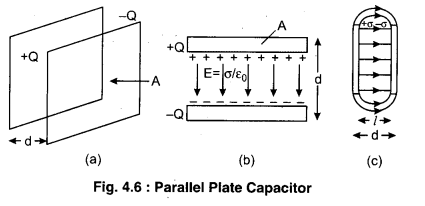
To charge the capacitor, the plates are connected to a battery. The plate attached to the positive terminal of the battery release electrons where as that plate which is attached to the negative terminal of accepts electrons. Thus, the charges at both the plates are +Q and -Q respectively. As the area of both the plates are same, so, the surface charge densities at both the plates are +σ and -σ respectively.
As the distance between the plates is very small as compared to their size. Thus, electric field between the plates due to each plate is \(\frac{\sigma}{2 \varepsilon_{0}}\) and the electric field due to both plates is in the same direction. Thus, the electric field lines between the plates are parallel and the electric field is uniform, [see figure 4.6 (b)]
Electric field between the plates,
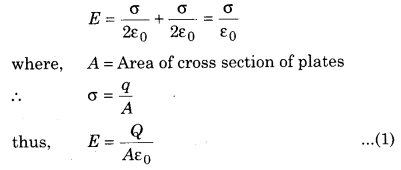
Surface charge density is more at the ends of the plates. Due to this, the electric field lines repel each other and the electric field becomes non-uniform [figure 4.6(c)].
If the distance between the plates is d, then the potential difference between the plates,
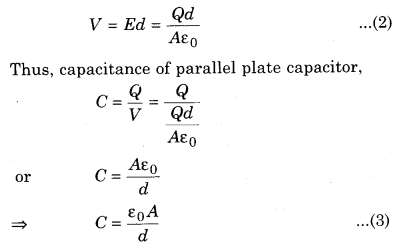
Clearly, capacitance of a parallel plate capacitor is directly proportional to the area of cross section of plates and inversely proportional to the distance between the plates.
i.e., C ∝ A
and C ∝ \(\frac{1}{d}\)
Question 2.
Obtain the capacitance for a parallel plate capacitor partially filled with a dielectric substance.
Answer:
Capacitance of Parallel Plate Capacitor Partially Filled with a Dielectric Medium.
Suppose the area of each plate of the capacitor is A, the distance between the plates d; t is the thickness of dielectric medium slab. Total potential difference between the plates is V.
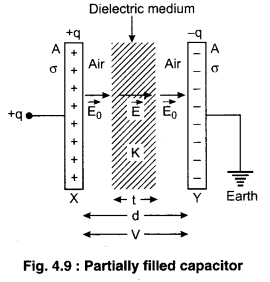
The surface charge density on each plate,
σ = \(\frac{q}{A}\) ……………. (1)
The intensity of electric field in air between the plates :
E0 = \(\frac{q}{A}\) …………… (2)
and that in dielectric medium, E = \(\frac{\sigma}{\varepsilon_{0} K}\) ………….. (3)
Now from the definition of potential difference, the potential difference between the plates,
V = work done in displacing unit positive charge from negative plate to positive plate.
= Work done in carrying + 1C charge through (d – t) distance in air +t distance in dielectric medium.
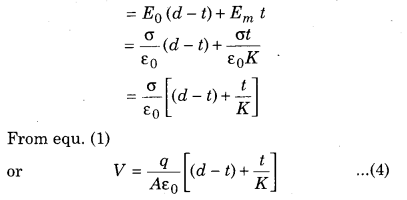
Therefore capacity of the parallel plate capacitor partially filled with dielectric medium.
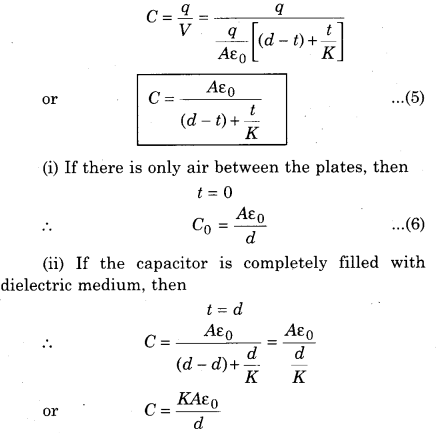
(iii) If there are n dielectric media of different constants and different thickness, as shown in adjoining figure, then

If no air space between the plates
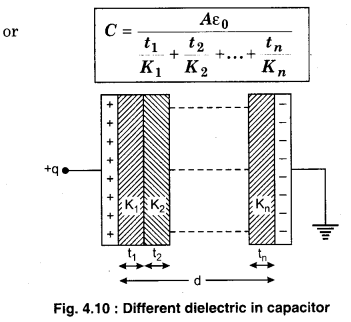
Question 3.
Obtain the formula for energy density of electric field between the plates of a parallel plate capacitor.
Answer:
Energy Density of a Parallel Plate Capacitor
If the area of cross section of each plate of a parallel plate capacitor is A, and the charged Q is given to the plates. Then, the electric field between its plates,
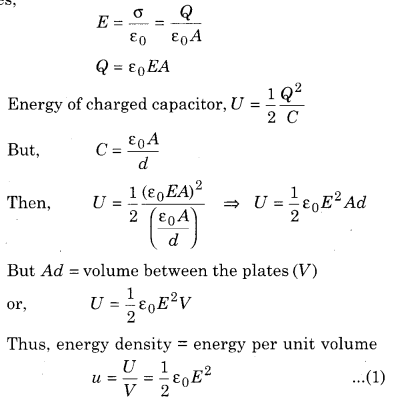
Though equation \(\left(U=\frac{1}{2} \frac{Q^{2}}{C}\right)\) is obtained for a parallel plate capacitor but it is also true for conservative electric field. Thus, for places, where there is electric field, electric potential energy per unit volume will be \(\frac{1}{2}\)ε0E2 . For parallel plate capacitor, E will be uniform and hence, U will be uniform.
Question 4.
What is a spherical capacitor? Obtain the relation for capacitance of a spherical capacitor.
Answer.
Capacitance of an Isolated Spherical Conductor
Suppose an isolated spherical conductor of radius R is placed in a medium of dielectric constant K. If on giving a charge q, its potential becomes V, then
V = \(\frac{1}{4 \pi \varepsilon_{0} K} \frac{q}{R}\)
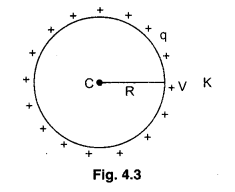
Therefore capacitance of spherical conductor,
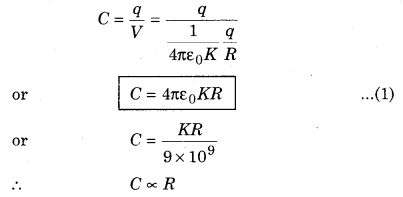
i.e., “the capacitance of spherical conductor is directly proportional to its radius.”
If Cm is the capacitance of the spherical conductor when it is placed in a medium of dielectric constant K and C0 when placed in vacuum or air, then,

i.e., dielectric constant of a medium is defined as the ratio of capacitance of a conductor placed in that medium and capacitance of same conductor when placed in air.
Question 5.
Explain the redistribution of charges on combining two charges conductors. Determining the ratio of charges after redistribution of charges and obtain the formula for loss of energy.
Answer:
Redistribution of Charges and Loss of Energy by Combination of Charged Conductors
Two charged conductors which have different potential are combined and then charges on them get
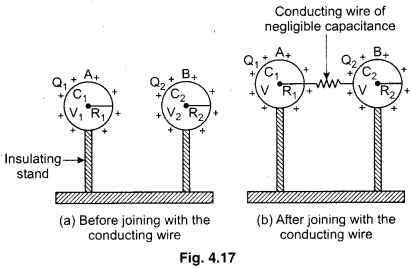
redistributed and the potential become same on both of it. In this process, a definite energy is lost.
Redistribution of Charges
From figure 4.17, two isolated conductors A and B are of radii R1 and R2 respectively and the capacitances are C1 and C2 respectively. On charging A by Q1 and B by Q2 , their potentials become V1 and V2 respectively.
Before joining the conducting wire,
Q1 = C1V1 …………. (1)
and Q2 = C2V2 ……………… (2)
Thus, total amount of charge on both the conductors,
Q = Q1 + Q2
or, Q = C1V1 + C2V2 …………… (3)
Now, if both the conductors are attached by a conducting wire of negligible resistance or capacitance. Then charge always flow the conductor of high potential to low potential and flows till the potential on both the conductors is same. In electrical equilibrium, let the potential be V and charges on the conductors be Q’1 and Q’2 respectively. Then, total capacitance on arrangement of the two conductors as a system, C = C1 + C2 because the potential on both the conductors is same and hence the conductors are in parallel combination.
After redistribution of charges,
Q’1 = C1V ………………. (4)
and Q’2 = C2V ……………. (5)
Then, total charge after redistribution,
Q = Q’1 + Q’2 = (C1 + C2) V
From law of conservation of charge,
C1V1 + C2V2 = (C1 + C2)V
Thus, common potential,

Thus, after redistribution of charges, the ratio of charges of conductors,

After redistribution of charges, the ratio of charges of conductors is in the ratio of their capacitances.
If V1 > V2
Then, V1 > V > V2
Change in potential of first conductor,
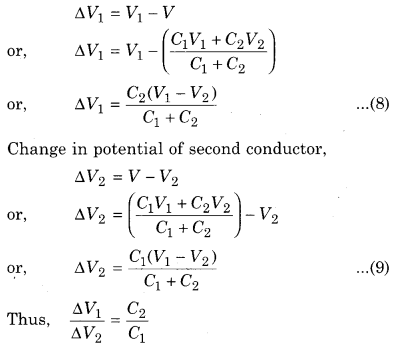
Hence, after the redistribution of charges, the ratio of change in potential of conductors is equal to the reciprocal of the ratio of their capacitances.
Energy Loss
In the redistribution process of charges, the charge flows through the conducting wire. Hence, some amount of energy is changed in the form of heat and some amount of energy is lost. It is due to the resistance of conducting wire.
Total potential energy of the system before joining conducting wire,
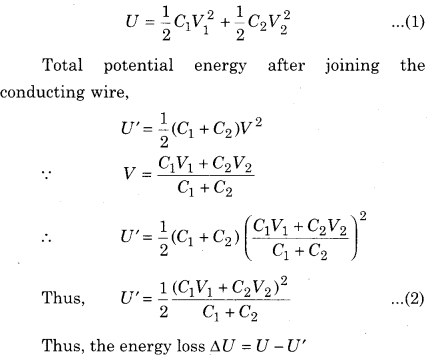
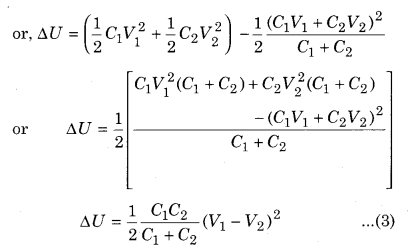
(V1 – V2)2 is always positive. Thus, on combining charged conductors and capacitors, in the redistribution of charges, there is always loss of energy.
If V1 = V2 Then, ΔC = 0
i. e., There is no flow of charges when potential of both the conductors is same. Hence, there is no loss of energy.
A battery of V volt charges the capacitor to give half of energy QV i.e., \(\frac{1}{2}\)QV is stored in the capacitor [Note: \(\frac{Q V}{2}\)]and rest half part \(\frac{1}{2}\) QVs lost in the form
RBSE Class 12 Physics Chapter 4 Numerical Problems Questions
Question 1.
The capacitance of a spherical conductor is 1 pF. Calculate its radius.
Solution:
Capacitance of spherical capacitor
(C) = 1PF= 1 × 10-12 F
Radius (R) = ?
Capacitance of spherical conductor (C) = 4πε0R
R = \(\frac{C}{4 \pi \varepsilon_{0}}\) = 9 × 109 × 1 × 10-12
= 9 × 10-3 m = 9 mm
Question 2.
The area of each plate of a parallel plate capacitor is 100 cm2 and the electric field intensity between the plates is 100 N/C. What is the charge on each plate?
Solution:
A = 100 cm2 = 100 × 10-4 m2 (given)
Electric field (E) = 100 N/C
Electric field intensity (E) = \(\frac{\sigma}{A}=\frac{q}{A \varepsilon_{0}}\)
q = Aε0E = 100 × 10-4 × 8.86 × 10-12 × 100
= 8.86 × 10-12 C (on each plate)
Question 3.
A parallel plate capacitor is given a definite potential difference. Keeping the potential difference same, a slab of thickness 3 mm is placed between the plates. To do this, the distance between the plates is increased by 2.4 mm. Calculate the dielectric constant of the slab.
Solution:
Capacitance of parallel plate capacitor
![]()
On introducing dielectric constant of thickness t

On introducing dielectric plate there will be no change of charge of capacitor. Therefore, to maintain same potential difference, its capacitance should be of initial value.
If now the distance between its plate is ‘d’, then
C = CK
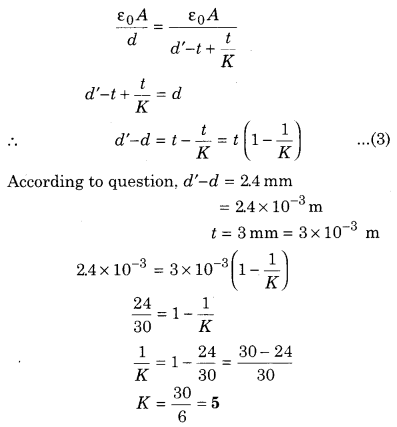
Question 4.
The capacitances of two capacitors are 2 μF and 4 μF. They are first connected in series combination and then in parallel combination. Compare the equivalent capacitances in both the cases.
Solution:
In series combination
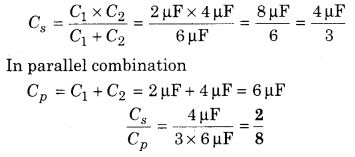
Question 5.
The radii of two charged metallic spheres are 0.05 m and 0.10 m. The charge on each sphere is 75 μC. Calculate (i) Common potential and (ii) Amount of charge flowing, when these spheres are connected by a thin wire.
Solution:
(i) Capacitance of first charged metal sphere
C1 = 4πε0R1
Capacitance of second charged metal sphere
C2 = 4πε0R2
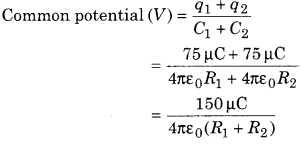
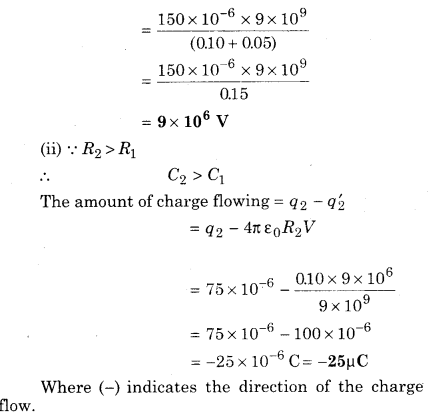
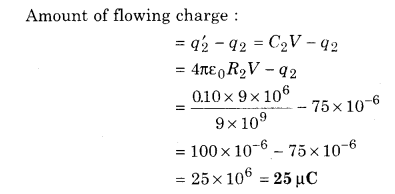
Question 6.
A spherical conductor of capacitance 2μF having a charge upto potential 150 volt is connected to an uncharged sphere of capacitance 1 μF. Calculate the common potential. Determine the charge on each conductor.
Solution:
Given, V1 = 150 volt. V2 = 0 (uncharged),
C1 = 2 μF and C2 = 1 μF
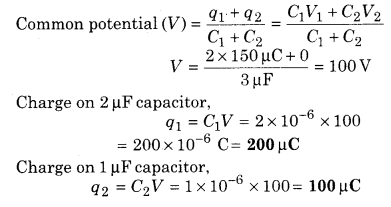
Question 7.
125 drops are charged to a potential of 200 volt. These drops are combined to form a big drop. Calculate change in potential energy.
Solution:
Volume of 125 small drops = Volume of one bigger drop
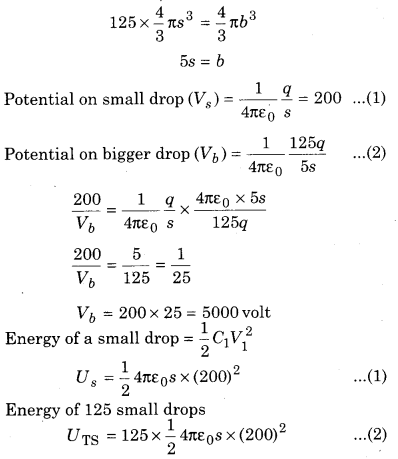
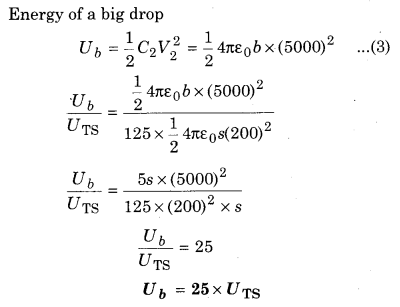
Question 8.
In the given figure, each capacitor is of capacitance 1 μF. Calculate the equivalent capacitance between the points A and B.
Solution:
Capacitance of each arm
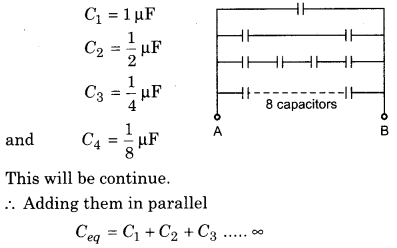
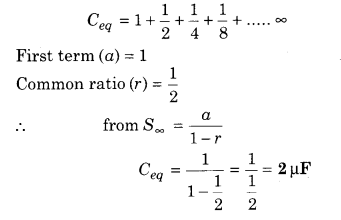
Question 9.
In the given figure, the equivalent capacitance between the points A and B is 5 μF. Calculate capacitance C.
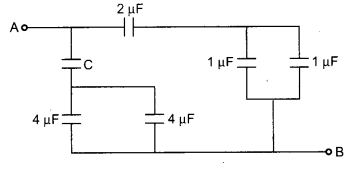
Solution:
Adding 1 μF and 1 μF in parallel
C’ = C1 + C2 = 1 μF + 1μF = 2μF
Adding C’ and 2μF in series
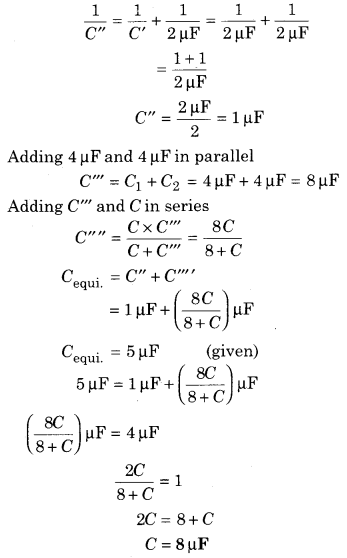
Question 10.
Calculate the capacitance of the capacitor as shown in figure. The area of each plates is A and distance between the plate is d.
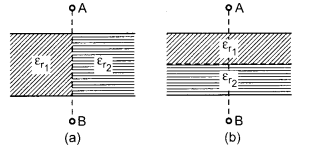
Solution:
First figure (a) cross-sectional area is divided into two parts. They will be connected in parallel.
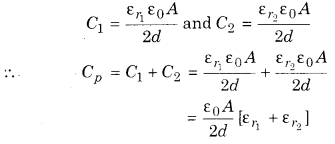
Here in the figure (b) distance between capacitors is divided into two equal parts, so they will be connected in series.
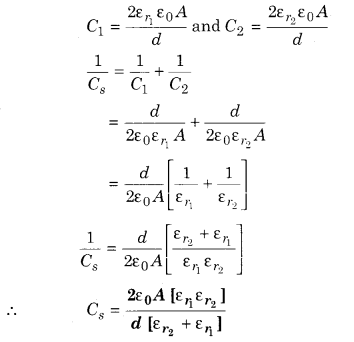
Question 11.
Calculate the equivalent capacitance between A and B.

Solution:
Adding 8 μF and 4 μF in series combination
C’ = \(\frac{C_{1} \times C_{2}}{C_{1}+C_{2}}=\frac{8 \times 4}{8+4} \mu \mathrm{F}\)
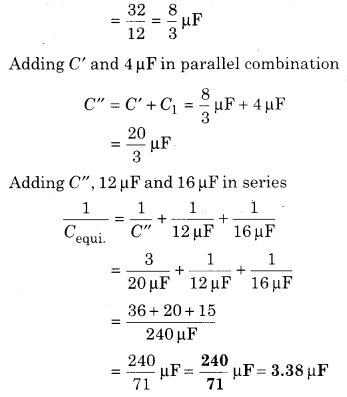
Question 12.
An isolated conductor is covered with a concentric spherical conductor whose outer surface is connected to the earth. The ratio of radius of these spherical conductors is \(\frac{n}{n-1}\)
Prove that on combination of these conductors, the capacitance of the spherical conductor will be n times.
Solution:
Let radius of spherical conductor is r2 and it is covered by radius r1
Capacity of spherical conductor (C1) = 4πε0r2
In second situation :
In second situation capacitance of spherical conductor
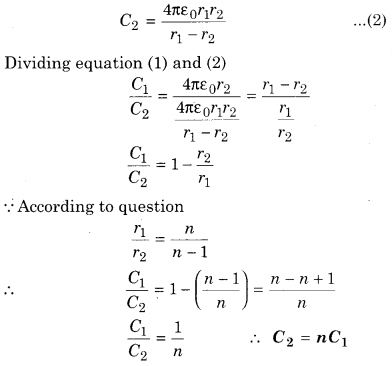
Question 13.
The stored energy density by a parallel plate capacitor is 4.43x 1(T10 J/m3. Calculate the electric field intensity between these plates. ε0 = 8.86x × 10-12 F/m.
Solution:
Energy density (u) = 4.43 × 1(10-10) J/m3
Intensity of electric field E = ?
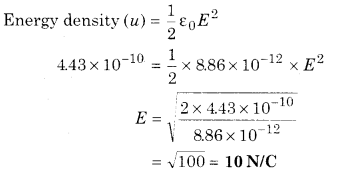
Question 14.
Calculate the capacitance between the system as shown in figure, if the area of each plate is A and the distance between two adjacent plates is d.
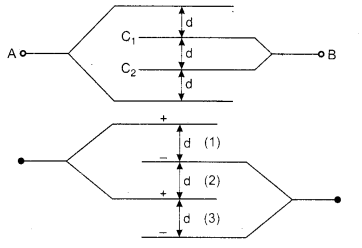
Solution:
(i) As two negative plates are with each other, so this is not capacitor.
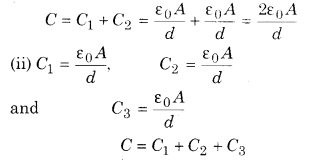

Question 15.
n capacitors of C capacitance are connected in series to give CS as the equivalent capacitance and on arranging in parallel, the equivalent capacitance is Cp, then prove that Cp – Cs = \(\left(\frac{n^{2}-1}{n}\right) C\)
Solution:
In series
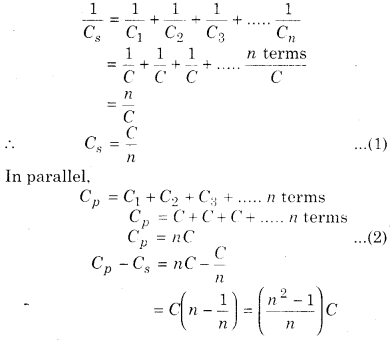
Question 16.
The radius of each plate in a parallel plate capacitor is 10 cm. If the distance between the plates is 10 cm, then calculate the capacitance of capacitor in air.
Solution:
Radius of plate = 10 cm = 10 × 10-2 m
Cross sectional area of plate ( A) = πr2
= π × (10 × 10-2 )2
Distance between plate (d) = 10 cm – 10 ×10-2 m
Capacitance of parallel plate capacitor
